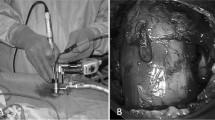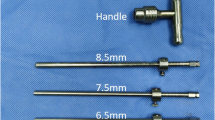Abstract
Satisfactory short- and mid-term results have been observed following microscopic decompression with tubular retractor (MDT) and conventional microscopic decompression (CMD) in lumbar spinal stenosis (LSS). It is not yet clear which surgical procedure is the optimal treatment for LSS, especially in long-term follow-up period. To the best of our knowledge, there is no comparative study analyzing the clinical–radiological outcomes of MDT and CMD over a 10-year follow-up periods. The purpose of this study was to evaluate and compare clinical and radiological outcomes of MDT and CMD over a 10-year follow-up period in patients with LSS. Of total 121 patients, 102 patients (53 MDT and 49 CMD) were followed for at least 10 years following MDT and CMD for LSS. We retrospectively reviewed surgical results and clinical outcomes based on the visual analogue scale, McNab’s criteria, and the Oswestry Disability Index, and radiological analysis results with the parameters, including the change of disk height and intervertebral distance, obtained preoperatively and 3- and 6-month, and 1-, 6-, and 10-year postoperatively. There was no significant difference in patient demographics between the two groups. Five patients (two in MDT, three in CMD) required re-operation for re-stenotic change of the affected segment. The number of patients requiring re-operation was not significantly different between the two groups (p > 0.05). No statistically significant differences were observed between the groups in a long-term follow-up period after a 3-month follow-up (p > 0.05). However, in the acute postoperative phase of <3-month postoperatively, MDT appears to result in less postoperative pain and better clinical outcomes compared with the CMD. In conclusion, despite relatively small sample size with retrospective design, our study suggested that MDT appears to result in less postoperative pain and better clinical outcomes in the acute postoperative period of <3 months, but both MDT and CMD were no significant differences in clinical and radiological outcomes after that time.



Similar content being viewed by others
References
Oppenheimer JH, DeCastro I, McDonnell DE (2009) Minimally invasive spine technology and minimally invasive spine surgery: a historical review. Neurosurg Focus 27:E9
Guiot BH, Khoo LT, Fessler RG (2002) A minimally invasive technique for decompression of the lumbar spine. Spine (Phila Pa 1976) 27:432–438
Iguchi T, Kurihara A, Nakayama J, Sato K, Kurosaka M, Yamasaki K (2000) Minimum 10-year outcome of decompressive laminectomy for degenerative lumbar spinal stenosis. Spine (Phila Pa 1976) 25:1754–1759
Carreon LY, Puno RM, Dimar JR II, Glassman SD, Johnson JR (2003) Perioperative complications of posterior lumbar decompression and arthrodesis in older adults. J Bone Joint Surg Am 85-A:2089–2092
Porter RW (1996) Spinal stenosis and neurogenic claudication. Spine (Phila Pa 1976) 21:2046–2052
Asgarzadie F, Khoo LT (2007) Minimally invasive operative management for lumbar spinal stenosis: overview of early and long-term outcomes. Orthop Clin North Am 38:387–399
Khoo LT, Fessler RG (2002) Microendoscopic decompressive laminotomy for the treatment of lumbar stenosis. Neurosurgery 51:S146–S154
Javid MJ, Hadar EJ (1998) Long-term follow-up review of patients who underwent laminectomy for lumbar stenosis: a prospective study. J Neurosurg 89:1–7
Turner JA, Ersek M, Herron L, Deyo R (1992) Surgery for lumbar spinal stenosis. Attempted meta-analysis of the literature. Spine (Phila Pa 1976) 17:1–8
Aryanpur J, Ducker T (1990) Multilevel lumbar laminotomies: an alternative to laminectomy in the treatment of lumbar stenosis. Neurosurgery 26:429–433
Thomé C, Zevgaridis D, Leheta O, Bäzner H, Pöckler-Schöniger C, Wöhrle J, Schmiedek P (2005) Outcome after less-invasive decompression of lumbar spinal stenosis: a randomized comparison of unilateral laminotomy, bilateral laminotomy, and laminectomy. J Neurosurg Spine 3:129–141
Young S, Veerapen R, O’Laoire SA (1988) Relief of lumbar canal stenosis using multilevel subarticular fenestrations as an alternative to wide laminectomy: preliminary report. Neurosurgery 23:628–633
Palmer S, Turner R, Palmer R (2002) Bilateral decompressive surgery in lumbar spinal stenosis associated with spondylolisthesis: unilateral approach and use of a microscope and tubular retractor system. Neurosurg Focus 13:E4
Weiner BK, Walker M, Brower RS, McCulloch JA (1999) Microdecompression for lumbar spinal canal stenosis. Spine (Phila Pa 1976) 24:2268–2272
Celik SE, Celik S, Goksu K, Kara A, Ince I (2010) Microdecompressive laminatomy with a 5-year follow-up period for severe lumbar spinal stenosis. J Spinal Disord Tech 23:229–235
Jang JH, Kim JD, Cha SW (2007) Minimally invasive microscopic decompression with tubular retractor system in lumbar spinal stenosis-results comparing with open microscopic decompression. J Korean Soc Spine Surg 14:79–86
Rosen DS, O’Toole JE, Eichholz KM, Hrubes M, Huo D, Sandhu FA et al (2007) Minimally invasive lumbar spinal decompression in the elderly: outcomes of 50 patients aged 75 years and older. Neurosurgery 60(3):503–509
Sakura H, Hosono N, Mukai Y, Fujimori T, Iwasaki M, Yoshikawa H (2010) Preservation of muscles attached to the C2 and C7 spinous processes rather that subaxial deep extensors reduces adverse effects after cervical laminoplasty. Spine (Phila Pa 1976) 35:E782–E786
Podichetty VK, Spears J, Isaacs RE, Booher J, Biscup RS (2006) Complications associated with minimally invasive decompression for lumbar spinal stenosis. J Spinal Disord Tech 19:161–166
Mimran RI, Henn JS (2005) Minimally invasive lumbar decompression. Oper Tech Neurosurg 7:56–63
Conflict of interest
No funds were received in support of this work. No benefits in any form have been or will be received from a commercial party related directly or indirectly to the subject of this manuscript.
Author information
Authors and Affiliations
Corresponding author
Rights and permissions
About this article
Cite this article
Lee, G.W., Jang, SJ., Shin, S.M. et al. Clinical and radiological outcomes following microscopic decompression utilizing tubular retractor or conventional microscopic decompression in lumbar spinal stenosis with a minimum of 10-year follow-up. Eur J Orthop Surg Traumatol 24 (Suppl 1), 145–151 (2014). https://doi.org/10.1007/s00590-013-1287-x
Received:
Accepted:
Published:
Issue Date:
DOI: https://doi.org/10.1007/s00590-013-1287-x




